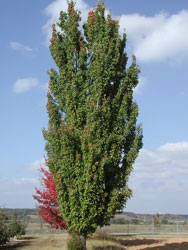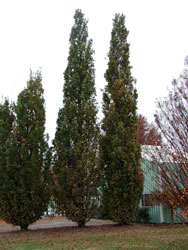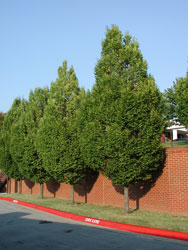Resource Library
Plant of the Week: Trees, Shade, Columnar or Fastigiate
The University of Arkansas System Division of Agriculture does not promote, support or recommend plants featured in "Plant of the Week." Please consult your local Extension office for plants suitable for your region.
Plant of the Week
Columnar or Fastigiate Shade Trees

Just like people, trees come in all shapes and sizes. Nowadays, thanks largely to the benefits of the ancient art of grafting, shade trees are sold as clones and we can select the size, growth form, fall color and flower color we like provided we are patient enough to seek them out. One of the interesting and useful growth habits available for most shade tree species is the fastigiate or columnar growth form.
Is there a difference between columnar and fastigiate?
While these two growth forms are often treated as synonyms, they are in reality variations on a theme. Columnar trees usually have a height to width ratio of 5-to-1 while fastigiate plants are closer to 10-to-1.Think of columnar plants as having the shape of a stove pipe while fastigiate plants take on the form of a power pole.
This narrow, upright growth habit is caused by the inability of some seedlings to develop normal, broad-spreading side branches. With these plants the main branches grow straight up instead of spreading sideways so they can better position themselves to intercept more light. For some reason – probably centered around the response of cells in the apical meristem to the level of a natural growth hormone called auxin – the balance between verticality and photosynthesis is swayed in favor of narrowness. Nurserymen, ever on the look out for something different, select these natural variants and maintain the form by grafting.
Does the form of fastigiate or columnar trees change with age?
A word of caution should be inserted here. The fastigiate or columnar growth form is most pronounced in the adolescence and youth of the tree. Like humans, they tend to become a bit squat as they pass the 30-year-old mark. These older trees are usually even more handsome and picturesque than their younger selves, but their height to width ratio definitely changes.
What are the best ways to use this tree shape in the landscape?

Using trees with the basic shape of an exclamation mark in the landscape requires some thought. Indiscriminately plunking down such a tree without considering its context with the rest of the landscape will look odd at best. In general, these columnar plants are best used in one of two ways; either as a tall, narrow vertical screen where the desire is to create a visual barrier or as a specimen plant where the unique growth form becomes a sculptural element in the scene.
If used as a vertical screen it is usually visually more appealing to plant several of the plants in a row so that the length of the planting is a minimum one-and-one-half times the mature height of the plants. Using this formula for the Armstrong red maple with a mature height of about 60 feet, we would need a 90-foot run of trees. Because of their narrow habit the trees are planted closer together – in this case on 10-foot spacing – so we would need nine trees.
When used as a specimen, these narrow plants are naturals to use to mark some entryway such as a driveway, garage doors of even into a different garden space. They can be used as a vertical accent near a large building as a part of an overall foundation planting. Individually, they can be used at a key focal point along a garden walkway.
Some good columnar or fastigiate trees include:
- Acer rubrum ‘Bowhall’ (Bowhall Red Maple) grows as a symmetrical elongated oval about 40 feet
tall with a mature spread of 10 feet. Good red fall color.
- Acer x freemanii ‘Armstrong’ (Armstrong Red Maple) is somewhat flat topped and grows about 60 feet
tall with a mature spread of10 to 15 feet. Not a dependable fall color display, but
red when it does happen.
- Carpinus betulus ‘Fastigiata’ (Fastigiate European Hornbeam) is a narrow column the first decade of
its life but
afterwards takes on a more egg-shaped habit of growth reaching 35 feet tall with a spread of 15 feet.
 These 12-year-old fastigiate European hornbeams are already starting to take on a more elongated oval form as they age. (Image courtesy Gerald Klingaman)Download the High Resolution
These 12-year-old fastigiate European hornbeams are already starting to take on a more elongated oval form as they age. (Image courtesy Gerald Klingaman)Download the High Resolution - Ginkgo biloba ‘Princeton Sentry’ (Columnar Ginkgo) is slow growing but worth the wait. It can
grow 60 feet tall with a spread of up to 20 feet at its base. Beautiful yellow fall
color.
- Liquidambar styraciflua ‘Slender Silhouette’ (Columnar Sweetgum) grows to 40 feet tall with a 4-foot spread.
Good burgundy fall color and relatively few sweetgum balls.
- Quercus palustris ‘Green Pillar’ (Columnar Pin Oak) grows to 40 feet tall with an 8-foot spread. Good
red fall color.
- Quercus robur ‘Fastigiata’ (Columnar English Oak) grows to 50 feet tall with an 8-foot spread.
Not great fall color but a handsome tree.
- Quercus x warei ‘Regal Prince’ (Columnar Hybrid Oak) is a hybrid between the English oak and the swamp white oak with powdery mildew resistance.
By: Gerald Klingaman, retired
Retired Extension Horticulturist - Ornamentals
Extension News - March 22, 2013
The University of Arkansas System Division of Agriculture does not maintain lists of retail outlets where these plants can be purchased. Please check your local nursery or other retail outlets to ask about the availability of these plants for your growing area.